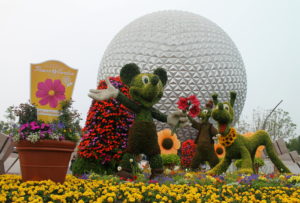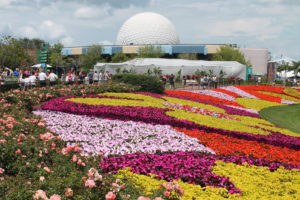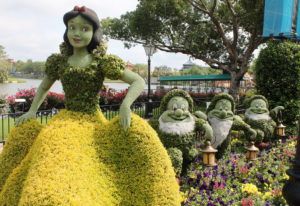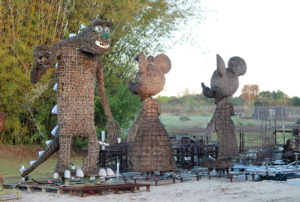The Not-So-Secret Secret Gardens of Epcot
April 17th, 2018
One of my favorite public gardens really isn’t a public garden at all.
It’s the Epcot theme park at Walt Disney World near Orlando, Florida – 320 acres of colorful, neatly landscaped gardens, grounds, and displays.
But because Epcot’s main draws are the rides and attractions, the scope of what’s there plant-wise gets overlooked.
This place has a lot to offer gardenly (if that’s a word)… tropical trees, ribbon beds of 70,000 annual flowers each year, 200 hundred hanging baskets, theme gardens from around the world (China, Japan, Canada, England, and France in particular), flower planters that float on water, 7-foot-tall “flower towers” that look like blooming pyramids, a huge hydroponics operation, and probably most famous, the topiary collection.
To see Epcot in its full horticultural glory, visit between March and May during the annual, three-month Epcot Flower and Garden Festival. This is when Disney hauls out even more flowers, plus additional festival-only gardens, food-sampling with edible gardens, and special tours and exhibits.
Epcot has been running the festival for 25 years, and it’s been getting bigger and longer each year. I’m just back from this year’s version and posted a photo gallery of the 2018 festival to give you a feel for the highlights.
I also posted a video of 20 scenes from the festival on Pennlive.com (the website of The Patriot-News).
While at the 2018 Epcot flower festival, I went on a three-hour, in-depth tour of Epcot’s plants and gardening practices with Disney horticulturist Lisa Bernardini. It was a fascinating three hours.
Lisa gave the inside scoop on how Disney creates the 100+ oversized festival topiaries – most of them Disney characters.
Topiaries have been a hallmark of Disney parks since 1963 when the first ones appeared at California’s Disneyland.
Walt Disney himself came up with the idea after he saw topiaries at Tivoli Gardens in Copenhagen, Denmark.
Topiaries are generally evergreens sheared into various shapes, but Disney’s original horticulturist, Bill Evans, proposed using sphagnum-moss-stuffed frames to give more flexibility.
At first, the frames were covered completely with plants. While that was botanically “pure,” it wasn’t easy to produce replicas of Mickey, Goofy, and crew.
Disney’s Eric Darden says some of the early topiaries were so gangly that staff had to place signs so guests could tell what they were seeing.
These days, most of the character faces and intricate body parts are made out of sculpted and painted fiberglass. But as much as possible is still created using live plants… or at least plant parts.
Bernardini said that a favorite part material is moss, which is ideal for its velvety texture and short growth habit.
Another favorite is coconut fiber, which is perfect for beards and for character parts like the holster on Sheriff Woody or the mane on Circle of Life’s Mufasa lion.
To create a topiary character, the first step is bending and welding metal rods into the character’s shape. Then the frames are stuffed with damp sphagnum moss like the kind used in lining metal hanging baskets.
“We stuff a little, pack it, and stuff some more until we get it jam-packed,” says Bernardini. “Then we wrap it with deer netting. We found that works better than chicken wire, which kept stabbing people. It isn’t as flexible either.”
Irrigation lines are snaked through the frames at this point.
Bernardini says topiary characters used to be hand-watered, but it was nearly impossible to keep small parts like noses and fingers damp enough in Florida’s heat to keep them alive for long.
“Now we can run irrigation through them as long as we want or even all day long,” she says.
Once the frame is stuffed and wrapped, Disney topiary-makers use a dibble – a pointed hand tool – to poke holes through the net openings and into the moss. Then plant “plugs,” which are baby plants with root balls about the size of a thumb, are inserted into holes.

Mosses, creeping fig, and alternanthera are three of the most commonly used plants for character topiaries.
Creeping fig is one of the most-used plants when the color green is needed. For red, alternanthera is the plant of choice. For purple, ajuga works well. And for gold, golden creeping sedum is best.
Moss also can be spray-painted any color.
Hair pins are used along with trimming to keep the stems tight to the forms.
“Ideally, you want to give topiaries two to three months to grow out and root before going on display,” says Bernardini. “But we’ve done it in as little as three days.”
That’s also an advantage over sheared evergreen topiaries, which can take seven to 10 years to grow and shape.
After a few months on park display, the topiaries go backstage to the Disney nursery (the “topiary hospital”) for some TLC until their next tour of duty.
A sphagnum-moss topiary typically lasts three to five years.
“By then, the moss deteriorates in the middle,” Bernardini says. “Then the dresses or bodies start to cave in.”
Disney is constantly producing new topiaries to replace old ones or to represent the latest characters.
You won’t actually see any of this – or most any gardening work, for that matter – since Disney, 1.) doesn’t want to disturb guests with rototillers, blowers, or disheveled workers toting buckets, and 2.) wants to portray the botanical beauty as “magic that just happens.”
Those park flower beds you might see with a thousand or more flowers? Come back the next day, and the bed will “magically” be planted with all different flowers.
That’s because staff waits until the last guest is out of the park at night, then they swoop in to yank the spent flowers and immediately replant with thousands of new ones.
Bernardini says lamp stands are used to garden at night, “but a lot of our gardeners wear head lamps.”
Most Disney park beds are changed four times a year – in January, March, June, and September to stay fresh in the changing (and often brutal) central-Florida weather. Some beds are turned over five or six times a year.
The yanked flowers are sent off site to be composted, while most of the staged or container-displayed trees and shrubs are permanently planted somewhere on Disney property.
“One of the hardest challenges we have is finding plants that will grow here that you’d find in Canada or the U.K. or Norway,” Bernardini says.
The World Showcase part of Epcot is especially difficult because 11 different countries – each with their own plants – are represented around the same lagoon.
The solution is look-alike plants.
Disney will use a more heat-tolerant variety of cypress, for example, instead of a similar-looking juniper that’s native to the North. Sycamores make good substitutes for maples, river birch is a good substitute for aspen or white birch, and podocarpus is a good substitute for yews.
It all adds up to an effort that rivals the best public gardens on the planet.
And even though Epcot isn’t labeled as a public garden, Disney doesn’t consider the plants there to be just supporting cast.
Says Darden: “Plants aren’t just peripheral to the show, they’re critical to the show. They’re guardians of the first impression.”
Take a Pennlive peek behind the scenes at how Disney creates its plant masterpieces.
See George’s profiles on public gardens worth seeing.











